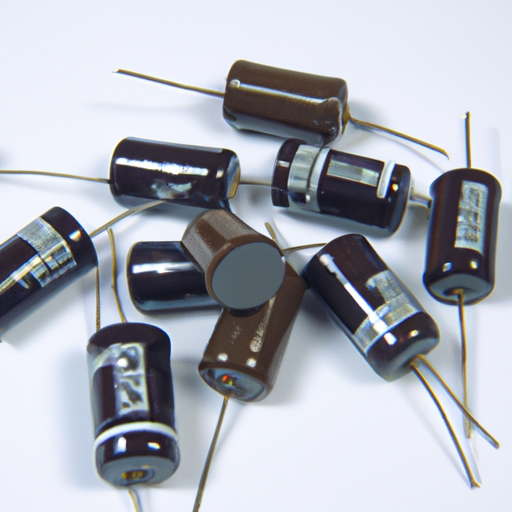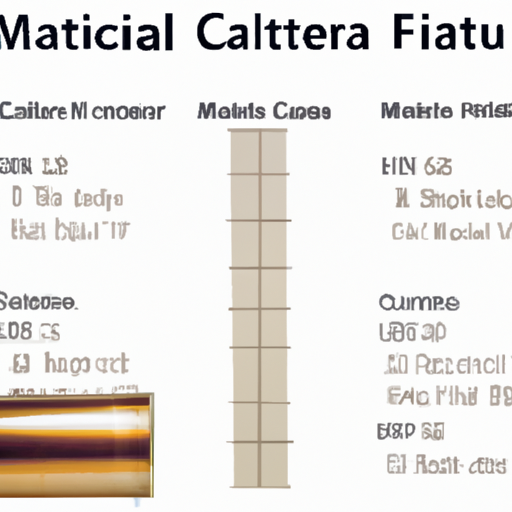What are the product features of capacitors?
What are the Product Features of Capacitors?
I. Introduction
A. Definition of Capacitors
Capacitors are passive electronic components that store and release electrical energy in a circuit. They consist of two conductive plates separated by an insulating material known as a dielectric. When a voltage is applied across the plates, an electric field is created, allowing the capacitor to store energy in the form of an electric charge.
B. Importance of Capacitors in Electronic Circuits
Capacitors play a crucial role in various electronic applications, from power supply filtering to signal processing. They help stabilize voltage and power flow, filter out noise, and store energy for later use. Their versatility makes them essential components in almost every electronic device, including smartphones, computers, and household appliances.
C. Overview of the Article
This article will explore the fundamental principles of capacitors, their key product features, specialized characteristics, and applications. Understanding these aspects will help you make informed decisions when selecting capacitors for your electronic projects.
II. Basic Principles of Capacitors
A. How Capacitors Work
1. Charge Storage Mechanism
When a capacitor is connected to a power source, electrons accumulate on one plate, creating a negative charge, while the other plate loses electrons, resulting in a positive charge. The amount of charge a capacitor can store is determined by its capacitance, which is influenced by the surface area of the plates, the distance between them, and the type of dielectric material used.
2. Capacitance and Its Measurement
Capacitance is measured in farads (F), with common subunits including microfarads (µF) and picofarads (pF). The capacitance value indicates how much charge a capacitor can store per volt of electrical potential applied across its plates.
B. Types of Capacitors
There are several types of capacitors, each with unique characteristics and applications:
1. Electrolytic Capacitors
These capacitors are polarized and typically used for high-capacitance applications, such as power supply filtering. They have a larger capacitance value but are sensitive to voltage and temperature.
2. Ceramic Capacitors
Ceramic capacitors are non-polarized and widely used in high-frequency applications. They are known for their stability and reliability.
3. Film Capacitors
These capacitors use a thin plastic film as the dielectric. They are known for their low ESR and high voltage ratings, making them suitable for audio and power applications.
4. Tantalum Capacitors
Tantalum capacitors are also polarized and offer high capacitance in a small package. They are commonly used in portable electronics but can be sensitive to voltage spikes.
5. Supercapacitors
Supercapacitors, or ultracapacitors, have extremely high capacitance values and are used for energy storage applications, such as in electric vehicles and renewable energy systems.
III. Key Product Features of Capacitors
A. Capacitance Value
1. Definition and Importance
The capacitance value indicates the amount of charge a capacitor can store. It is a critical parameter that affects the performance of the capacitor in a circuit.
2. Units of Measurement (Farads, Microfarads, etc.)
Capacitance is measured in farads (F), with common values ranging from picofarads (pF) for small capacitors to several farads for supercapacitors.
B. Voltage Rating
1. Definition and Importance
The voltage rating indicates the maximum voltage a capacitor can handle without breaking down. Exceeding this voltage can lead to failure or even catastrophic failure.
2. Breakdown Voltage and Safety Margins
It is essential to select a capacitor with a voltage rating higher than the maximum voltage it will encounter in the circuit, typically with a safety margin of at least 20%.
C. Tolerance
1. Definition and Importance
Tolerance refers to the allowable variation in capacitance from the specified value. It is crucial for ensuring that the capacitor performs as expected in a circuit.
2. Common Tolerance Values
Common tolerance values include ±5%, ±10%, and ±20%, with tighter tolerances available for precision applications.
D. Temperature Coefficient
1. Definition and Importance
The temperature coefficient indicates how the capacitance value changes with temperature. It is essential for applications where temperature fluctuations are expected.
2. Types of Temperature Coefficients
Common types include X7R, C0G, and Y5V, each with different stability characteristics over temperature ranges.
E. Equivalent Series Resistance (ESR)
1. Definition and Importance
ESR is the internal resistance of a capacitor that affects its performance, particularly in high-frequency applications. Lower ESR values are desirable for efficient energy storage and discharge.
2. Impact on Performance
High ESR can lead to power loss and heat generation, reducing the capacitor's efficiency and lifespan.
F. Lifetime and Reliability
1. Factors Affecting Lifetime
The lifetime of a capacitor can be influenced by factors such as temperature, voltage, and ripple current. Operating a capacitor within its specified limits can enhance its longevity.
2. Reliability Ratings (e.g., MTTF, MTBF)
Mean Time To Failure (MTTF) and Mean Time Between Failures (MTBF) are reliability metrics that help assess the expected lifespan of a capacitor in a given application.
G. Size and Form Factor
1. Physical Dimensions
Capacitors come in various sizes, and the physical dimensions can impact their suitability for specific applications, especially in compact electronic devices.
2. Mounting Types (Through-Hole, Surface Mount)
Capacitors can be mounted using through-hole or surface mount technology (SMT), with SMT being preferred for modern, compact circuit designs.
H. Dielectric Material
1. Types of Dielectric Materials
The dielectric material used in a capacitor significantly affects its performance. Common materials include ceramic, polyester, polypropylene, and tantalum oxide.
2. Impact on Performance and Applications
Different dielectric materials offer varying characteristics, such as stability, temperature tolerance, and voltage ratings, making them suitable for specific applications.
IV. Specialized Capacitor Features
A. Self-Healing Properties
Some capacitors, particularly film capacitors, have self-healing properties that allow them to recover from minor dielectric breakdowns, enhancing their reliability.
B. Low Leakage Current
Low leakage current is essential for applications where energy efficiency is critical, such as in battery-operated devices.
C. High Ripple Current Rating
Capacitors with high ripple current ratings can handle fluctuating currents without overheating, making them suitable for power supply applications.
D. Frequency Response
The frequency response of a capacitor indicates how its capacitance value changes with frequency. This characteristic is crucial for applications in signal processing and filtering.
E. Environmental Considerations
1. RoHS Compliance
Many manufacturers ensure that their capacitors comply with the Restriction of Hazardous Substances (RoHS) directive, which limits the use of certain hazardous materials.
2. Temperature and Humidity Ratings
Capacitors are rated for specific temperature and humidity ranges, ensuring reliable performance in various environmental conditions.
V. Applications of Capacitors
A. Power Supply Filtering
Capacitors are widely used in power supply circuits to smooth out voltage fluctuations and filter out noise, ensuring stable operation.
B. Signal Coupling and Decoupling
In signal processing, capacitors are used to couple and decouple signals, allowing for the transmission of AC signals while blocking DC components.
C. Timing Circuits
Capacitors are essential in timing circuits, where they work with resistors to create time delays in electronic devices.
D. Energy Storage
Capacitors store energy for later use, making them vital in applications such as flash photography and energy recovery systems.
E. Motor Start and Run Capacitors
In electric motors, capacitors are used to provide the initial boost of energy needed to start the motor and to maintain its operation.
VI. Conclusion
A. Summary of Key Features
Capacitors are versatile components with various features that influence their performance in electronic circuits. Understanding capacitance, voltage ratings, tolerance, ESR, and other characteristics is essential for selecting the right capacitor for your application.
B. Importance of Selecting the Right Capacitor
Choosing the appropriate capacitor can significantly impact the efficiency, reliability, and longevity of electronic devices. It is crucial to consider the specific requirements of your application when making a selection.
C. Future Trends in Capacitor Technology
As technology advances, we can expect to see innovations in capacitor design, materials, and applications, including the development of more efficient energy storage solutions and environmentally friendly capacitors.
VII. References
A. Suggested Reading
- "Capacitors: Principles and Applications" by John Smith
- "The Art of Electronics" by Paul Horowitz and Winfield Hill
B. Industry Standards and Guidelines
- IEC 60384: Fixed capacitors for use in electronic equipment
- EIA-198: Standard for Capacitor Reliability
By understanding the product features of capacitors, you can make informed decisions that enhance the performance and reliability of your electronic projects. Whether you are designing a new circuit or troubleshooting an existing one, the right capacitor can make all the difference.


